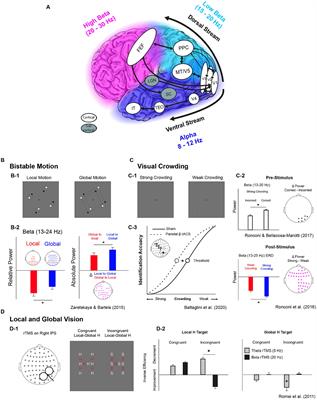Beta oscillations in vision: a (preconscious) neural mechanism for the dorsal visual stream?
Neural oscillations in alpha (8–12 Hz) and beta (13–30 Hz) frequency bands are thought to reflect feedback/reentrant loops and large-scale cortical interactions.

In the last decades a main effort has been made in linking perception with alpha-band oscillations, with converging evidence showing that alpha oscillations have a key role in the temporal and featural binding of visual input, configuring the alpha rhythm a key determinant of conscious visual experience. Less attention has been historically dedicated to link beta oscillations and visual processing. Nonetheless, increasing studies report that task conditions that require to segregate/integrate stimuli in space, to disentangle local/global shapes, to spatially reorganize visual inputs, and to achieve motion perception or form-motion integration, rely on the activity of beta oscillations, with a main hub in parietal areas. In the present review, we summarize the evidence linking oscillations within the beta band and visual perception. We propose that beta oscillations represent a neural code that supports the functionality of the magnocellular-dorsal (M-D) visual pathway, serving as a fast primary neural code to exert top-down influences on the slower parvocellular-ventral visual pathway activity. Such M-D-related beta activity is proposed to act mainly pre-consciously, providing the spatial coordinates of vision and guiding the conscious extraction of objects identity that are achieved with slower alpha rhythms in ventral areas. Finally, within this new theoretical framework, we discuss the potential role of M-D-related beta oscillations in visuo-spatial attention, oculo-motor behavior and reading (dis)abilities..
Read the full article at the original website
References:
